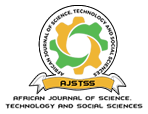Comparative study on the effects of quarry dust and natural fines on performance of concrete blocks
DOI:
https://doi.org/10.58506/ajstss.v1i1.50Keywords:
Concrete blocks, Quarry dustAbstract
Natural fine aggregates have been used in the construction industry to bind with cementing materials in the presence of water for building structures. Its use has led to increased daily demand with a subsequent rise in prices as the reserves get exhausted. Its overdependence has resulted in increasing scarcity because of over-harvesting from river beds causing an increase in demand. Moreover, uncontrolled sand harvesting has imposed dire impacts on the various environmental subcomponents of the river ecosystem such as water quality and quantity, bedforms, sediment milieu, flora and fauna, and socio-economic conditions of the people in the long run. This has led to the agitated search for an ecofriendly and less expensive substitute that can produce comparable compressive strength when used in concrete making. Quarry dust, a waste product of the quarry's grinding operation, is gaining momentum as a viable alternative to the conventional aggregates in concrete manufacturing due to its accessibility and lower cost. Quarry dust poses environmental pollution when dumped hence its use in the production of concrete will mitigate the pollution. This research was to determine the impacts of the addition of quarry dust in the performance of Concrete blocks (CB). This was achieved through the evaluation of the compressive strength of the CBs when quarry dust is used instead of natural fine aggregates. The concrete blocks were cast using molds of size 150 mm x 150 mm x 150 mm and then cured for seven days, fourteen days, and twenty- eight days. The size of particle distribution, the slump and workability test, and compressive strength was done respectively for the fresh and cured concrete blocks. The 28-day prepared CBs were subjected to alternate dry and wet cycles to assess their durability performance. A cost-benefit analysis of the use of quarry dust in place of fine aggregates in CB was also be conducted. The results obtained was be subjected to a T-test to study the significant difference in the performance between CB and the control.


